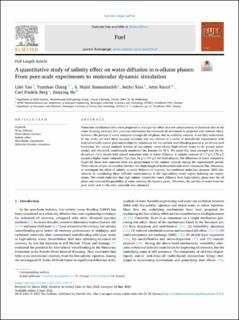| dc.contributor.author | Yan, Lifei | |
| dc.contributor.author | Chang, Yuanhao | |
| dc.contributor.author | Hassanizadeh, S. Majid | |
| dc.contributor.author | Xiao, Senbo | |
| dc.contributor.author | Raoof, Amir | |
| dc.contributor.author | Berg, Carl Fredrik | |
| dc.contributor.author | He, Jianying | |
| dc.date.accessioned | 2022-12-14T14:58:42Z | |
| dc.date.available | 2022-12-14T14:58:42Z | |
| dc.date.created | 2022-06-01T09:54:41Z | |
| dc.date.issued | 2022 | |
| dc.identifier.issn | 0016-2361 | |
| dc.identifier.uri | https://hdl.handle.net/11250/3037772 | |
| dc.description.abstract | Numerous mechanisms have been proposed to untangle the effect of a low concentration of dissolved salts in the water flooding medium. One potential mechanism for enhanced oil movement is proposed with osmosis effect, however, the process of water transport through the oil phase, due to a salinity contrast, is not fully understood. In our study, we used three aqueous solutions and two alkanes in a series of microfluidic experiments with hydrophobically coated glass micro-chips for mimicking the low-salinity waterflooding process in an oil-wet rock formation. We created multiple systems of low-salinity water-alkane/high-salinity water in the porous micromodel, and afterward, continuously monitored the domain for 70 hours. We noted that ionic strength and the hydrocarbon chain length both played important roles in water diffusion. A salinity contrast of 1.7 g/L-170 g/L caused a higher water volumetric flux than 50 g/L-170 g/L for both alkanes. The difference in water volumetric fluxes for those two contrasts were not proportional to the salinity contrast during the experimental period. There was no simple relationship between the chain length of hydrocarbon and water volumetric flux. Moreover, to investigate the effect of salinity on water behavior in heptane, we conducted molecular dynamic (MD) simulations by considering three different concentrations in the high-salinity water region featuring our experiments. The results indicated that high salinity limited the water diffusion from high-salinity phase into the oil phase and reduced the possibility of water entering the heptane phase. Therefore, the net flux of water from the pure water side to the salty waterside was enhanced. | en_US |
| dc.description.abstract | A quantitative study of salinity effect on water diffusion in n-alkane phases: from pore-scale experiments to molecular dynamic simulation | en_US |
| dc.language.iso | eng | en_US |
| dc.publisher | Elsevier | en_US |
| dc.rights | Navngivelse 4.0 Internasjonal | * |
| dc.rights.uri | http://creativecommons.org/licenses/by/4.0/deed.no | * |
| dc.title | A quantitative study of salinity effect on water diffusion in n-alkane phases: from pore-scale experiments to molecular dynamic simulation | en_US |
| dc.title.alternative | A quantitative study of salinity effect on water diffusion in n-alkane phases: from pore-scale experiments to molecular dynamic simulation | en_US |
| dc.type | Peer reviewed | en_US |
| dc.type | Journal article | en_US |
| dc.description.version | publishedVersion | en_US |
| dc.source.journal | Fuel | en_US |
| dc.identifier.doi | 10.1016/j.fuel.2022.124716 | |
| dc.identifier.cristin | 2028646 | |
| dc.relation.project | Norges forskningsråd: 234626 | en_US |
| dc.relation.project | Norges forskningsråd: 262644 | en_US |
| dc.relation.project | Notur/NorStore: nn9110k | en_US |
| dc.relation.project | Notur/NorStore: nn9391k | en_US |
| cristin.ispublished | false | |
| cristin.fulltext | postprint | |
| cristin.qualitycode | 2 | |

